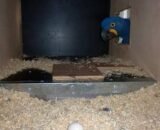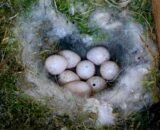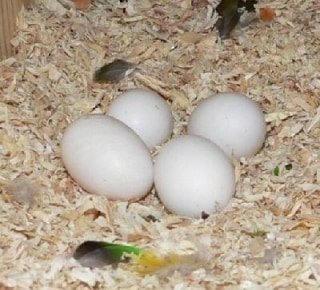- You have no items in your shopping cart
- Subtotal: $0.00
Not only from Caique Parrot Egg bold colors, but from their funny personality. They are relatively quiet as far as no squawking, but can still make high pitch calls, learn various whistles, and mimic other noises as well. The White Bellied Caique originates in South America. They weigh about 150-170 grams are about 9- 10 inches in length. Their diet in the wild consists of fruits and seeds. Caiques also have an oil preening gland to clean their feathers, so those with allergies may consider one of these guys.
Caique Breeding & Egg Laying
Breeding
Here in South Florida our Caique Parrot Egg pairs begin to lay in early January. In northern climates where birds are kept indoors they can breed just about any time of year. A productive pair can multiple clutch depending on whether or how long babies are left in the nest. It is generally not necessary to intervene to avoid breeding as you would with Cockatiels, budgies, lovebirds, etc. which are known to be habitual egg layers.
Egg Laying
A Caique hen will appear very swollen in the vent area before eggs are laid. Another indication of impending egg laying is extremely large droppings. The average clutch will usually be three to four eggs, although occasionally up to 5 or even 6 can be laid! The eggs will generally be laid every third day until the clutch is completed. The hen will not always sit tight until the second or third egg is laid. It’s not unusual to see several clutches of clear eggs before fertile Caique Parrot Egg are produced. A pair may go through several cycles before actually producing chicks.
Broken/Missing Eggs
Some inexperienced pairs may destroy their Caique Parrot Egg or chicks. If a squabble has taken place in the nestbox and an egg has broken, the hen may eat the broken egg in an attempt to keep the nestbox clean. If the eggs are being deliberately destroyed, replace the newly laid egg with a ceramic or wooden egg. Once the birds realize the eggs can’t be destroyed, often the pair will settle down and the next clutch will go smoothly.
If a pair continues to break their eggs, try to determine which bird is the culprit. If it is the male, he can be removed from the cage the evening before the next egg is due and returned only after you have recovered the egg. If the female is the guilty bird there is not much you can do but try to get the egg as soon as it is laid and replace it with a ceramic or wooden egg.
For pairs that play soccer in their nestboxes, eggs are removed immediately upon discovery and are fostered to another incubating pair. The removed egg is replaced with an infertile or “clear” egg from another pair. It is possible to substitute with ceramic or wooden eggs, but, since they can’t be broken, I would not know if the behavior had been curbed. Pairs can eventually settle down and stop breaking their Caique Parrot Egg.
Incubation
Some hens will sit tight after laying the first Caique Parrot Egg. In a large clutch this can cause a vast age difference between the oldest and youngest chicks. With a good candling light, and an experienced eye, fertility can usually be observed about 5 days after incubation begins.
The incubation period for Caiques is 25-26 days. The hen will spend all of her time in the nestbox coming out only to defecate. The male will feed her either in the nest box or at the entrance hole. Sometimes a male will even help incubate the eggs, although it is uncommon. If several eggs have been laid before the hen begins incubating, it is possible for several chicks to be hatched on the same day.







Customer reviews
Reviews
There are no reviews yet.
Write a customer review